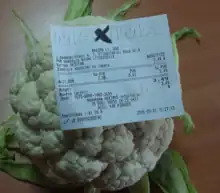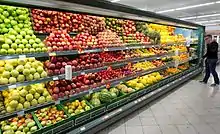
Cauliflower revolution (Lithuanian: Kalafiorų revoliucija) is the name of the spontaneous Lithuanian protest started by a resident of the southwestern Lithuanian town of Vilkaviškis in 2016.[1] She had bought a head of cauliflower at a Maxima supermarket in Vilkaviskis, paying €3.49 for one head of cauliflower. She posted the photo on Facebook, and soon tens of thousands of Lithuanians shared the post, going viral by tapping into negative sentiment stirred up by recent public discussions on rapidly rising prices[2] and a comparatively slow growth of salaries[3][4] after the euro was introduced to Lithuania in 2015. A spontaneous three-day boycott occurred, between May 10 and 12, of the four main supermarket chains (which controlled 80% of food distribution in Lithuania), Maxima, Iki, Rimi, and Norfa.[5][6]
Opinions

Algirdas Butkevičius, Lithuania’s prime minister, said that most goods are imported from nations in the eurozone, and therefore, prices changes are due to reasons such as market challenges, bad harvests, etc. Nerijus Mačiulis, the chief economist at Swedbank said that the escalation in cauliflower prices was caused by a seasonal hike in global demand.[7]
References
- ↑ Tracevskis, Rokas M. (19 May 2016). "The Cauliflower Revolution hits supermarkets in Lithuania". The Baltic Times.
- ↑ "Septintą mėnesį iš eilės pastebimai auga maisto produktų kainos". 15min.lt. Retrieved 20 January 2019.
- ↑ "Minimum wage Lithuania". Archived from the original on 2016-06-10. Retrieved 2016-05-25.
- ↑ "Minimalus atlyginimas". Finansistas.net. Retrieved 20 January 2019.
- ↑ "KARFIOL REVOLUCIJA: Kako su se građani oborili cijene hrane u marketima!". 6yka.com (in Lithuanian).
- ↑ "Lithuania Faces a "Cauliflower Revolution" - Transitions Online". Tol.org. Archived from the original on 2016-05-23. Retrieved 2016-05-25.
- ↑ "Lithuania's rising food prices spark 'cauliflower revolution'". The Guardian.